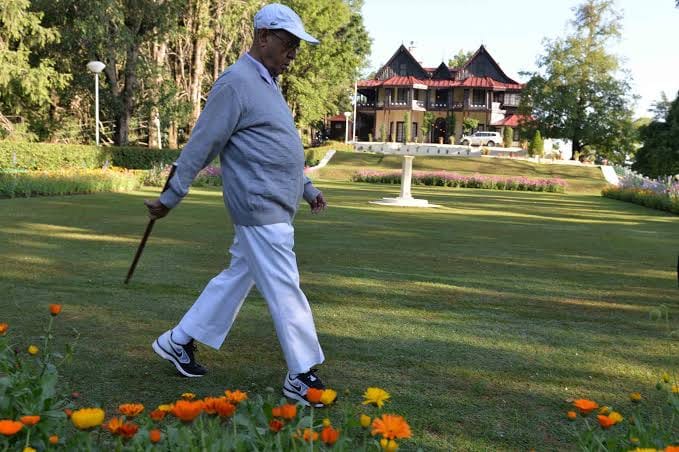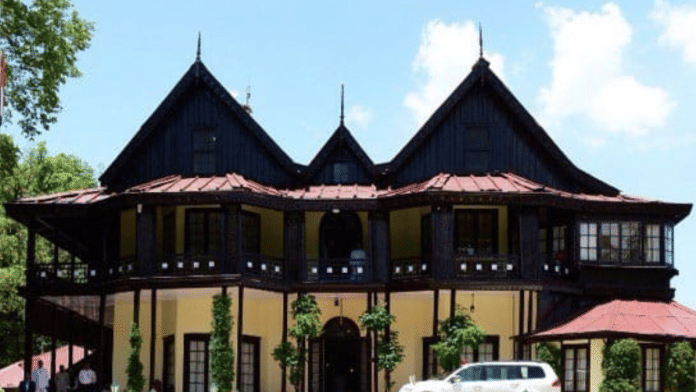Shimla: Thirteen kilometres from Shimla, nestled in the picturesque Mashobra Hills, is a 173-year-old building made entirely of wood. This regal colonial-era building, with its dajji hill architecture, sprawling gardens and surrounding forests of deodar and pine, is the Retreat Building, which is used as the President’s summer retreat.
On 20 April this year, this 10,628-square-foot structure, also called the Rashtrapati Nivas, will be thrown open to the public — for the first time — by President Droupadi Murmu, who will be in Shimla from 18-21 April.
Rakesh Gupta, additional secretary to the President, said that the retreat will remain open most days except for Mondays, gazetted holidays, and during the President’s tour of Shimla.
“This is an initiative of the President. Like Rashtrapati Nilayam in Hyderabad, and the Rashtrapati Bhavan in New Delhi, the retreat will be open for the public from 23 April,” Gupta said.
There will be an entry fee — Rs 50 for Indians and Rs 250 for foreign tourists — but students of government schools will be allowed free entry until 30 June.
The Rashtrapati Nivas will have a cloakroom, a cafe, and a souvenir shop. It will also have a wheelchair facility for the differently abled and the elderly, Gupta said. Tours can be booked through the official website of the President of India.
Although the building itself will be accessible to the public from 20 April, President Murmu is scheduled to open its sprawling gardens, including a small tulip garden, on the day of her arrival.
The structure, together with Shimla’s Viceregal Lodge — another historical building that’s currently used as the Indian Institute of Advanced Studies (IIAS) — has housed many viceroys and former Indian presidents, and local residents hope that the new building will help give a boost to tourism.
“Previously, this place was closed most of the time,” S.P. Singh, a tour guide in Shimla, told ThePrint. “People will get to see a new place which has a blend of colonial history and great Indian hill architecture. Earlier, this place used to remain closed most of the time.”
Also Read: ‘We are more, we are equal’: Story of Syed Mahmood, colonial India’s first Muslim HC judge
From Larty Saheb’s Kothi to the President’s Retreat
The iconic Rashtrapati Nivas, Chharabra, is steeped in history — it’s in this summer retreat that then prime minister Indira Gandhi stayed in 1972 during the signing of the Simla Agreement with the then Pakistan President Zulfikar Ali Bhutto, historian Raaja Bhasin, author of Simla the Summer Capital of British India, told ThePrint.

Built in 1850, the Retreat Building stands at an elevation of 7,000 feet. Edward Buck, a colonial-era civil servant and a long-time occupant of the place in the 19th century, attributed the construction of the building to a “Dr C”, a medical officer in the Raj.
The civil servant, who occupied the structure in 1881, wrote in his book Simla-Past and Present — considered the most authentic book on the area’s history — that William Hay, commissioner of the erstwhile Shimla hill states, took the building and the 300 acres of forest land around it on permanent lease in 1865.
It was after this that the structure came to be known as ‘Larty Sahib ki Kothi (Larty Sahib’s bungalow)’. Hay was referred to as Larty Sahib, according to the book.
Among those who lived in the structure were William Mansfield, a British military commander and the commander-in-chief of India, and Dietrich Brandis, the inspector general of forests, according to Shriniwas Joshi, a retired civil servant from Himachal Pradesh.
After this, the lease changed hands several times until 1881, when the widow of a government official Lionel Berkeley, held it, Joshi said.
It was through her that Buck, who had the charge of the department of revenue and agriculture for 15 years, came to live in the estate.
In 1896, the royal family took back the estates and the surrounding forest land.
“In 1896, Lord Elgin, the Viceroy, became Sir Edward’s tenant,” Joshi told ThePrint. “Sir Edward thought of transferring the estate permanently to the government as a viceregal residence because he was about to retire. But Rana of Koti (the king of the princely state), purchased the estate for Rs 35,000 and then gave it to the government on permanent lease.”
However, despite its storied past, the Retreat Building isn’t the original presidential residence. That honour went to the Viceregal Lodge, even though, according to Bhasin, several viceroys preferred staying at the Retreat Building instead.
“The building (the Retreat) has considerable historical significance,” he told ThePrint.
In 1964, Dr S Radhakrishnan, India’s second President, decided to convert the Viceregal Lodge into an institute of higher learning. It was then that the summer retreat moved to Chharabra, Joshi said.
Former President Ram Nath Kovind also stayed at the Retreat Building during his four-day visit to Shimla in September 2021.
Although she launched her presidential bid from Himachal last year, this is Murmu’s first official visit to the state since becoming president.
She’s scheduled to interact with students of the National Academy of Audit and Accounts, and attend a convocation at the Himachal Pradesh University, Shimla Deputy Commissioner Aditya Negi told ThePrint.
This is an updated version of the report.
(Edited by Uttara Ramaswamy)
Also Read: ‘Freedom from Brit slavery’ — Centre seeks proposals to rename Lansdowne hill station






